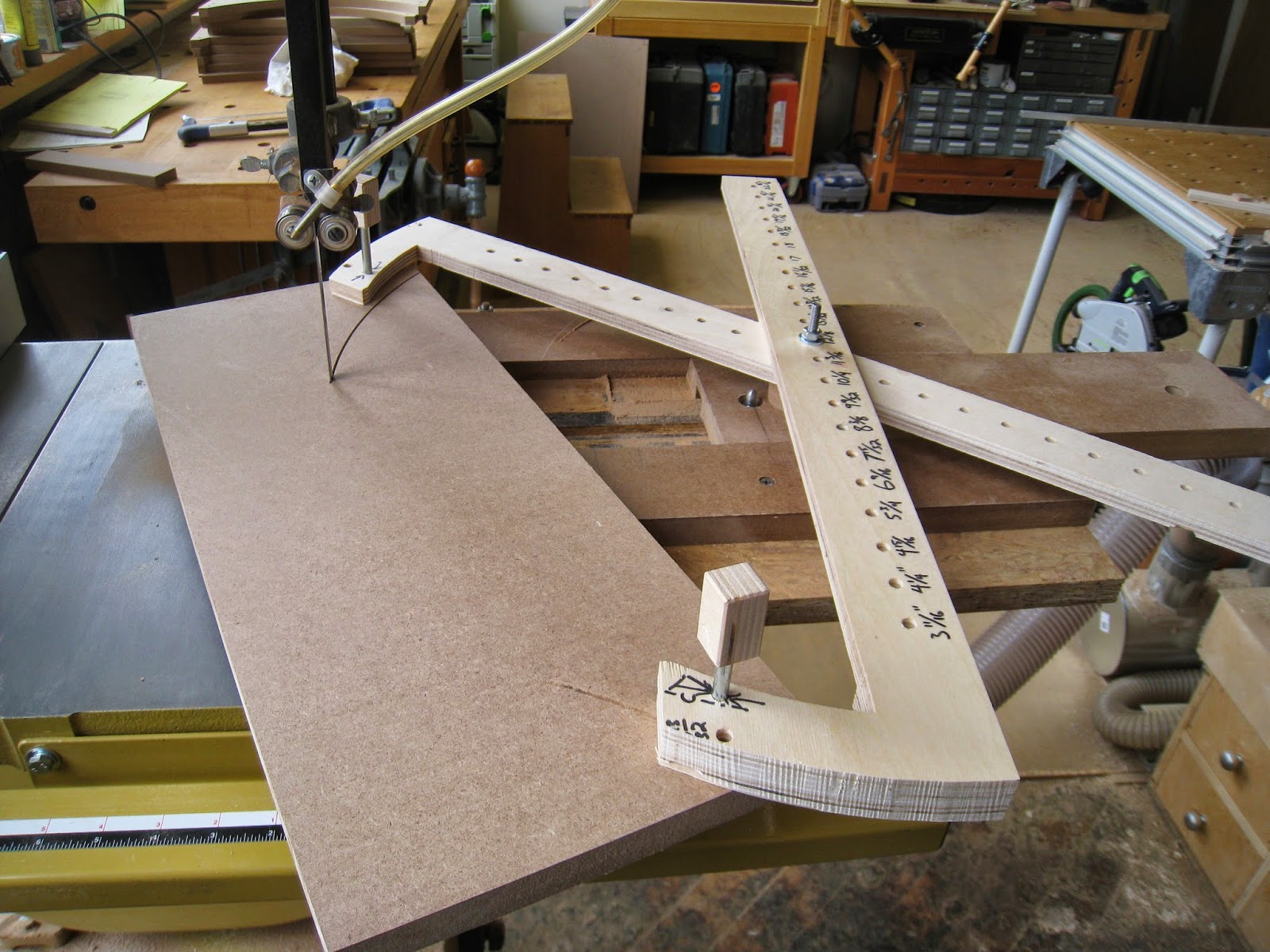In the photo, we have sliding center point jigs for the band saw, and for the router table: A dog-leg scissors jig (foreground, on the right) mounts to a blank, using non-threaded pins, to guide the blank while cutting inside or outside radii. There's a center pin that forms the pivot for the scissor jig, that protrudes from the bottom of the jig, and drops into a hole in the mating part of the radius jig, of which there are two: one that mounts to the jigsaw, one to the router table.
The first test for the jig was to make a pile of MDF layers that would stack up into a bending form. And this is as good a place as any to point out that this particular jig isn't the standard, or smart way to accomplish the task. So I'll also confess here to being a little too cerebral. Mark wandered over, asked what I was up to, and pointedly remarked that I was doing things in 'long-hand.' And he was right. There are many ways to skin this particular cat, and almost all of them are much more efficient. His suggestion (based on much more experience than I have) was to cut one master curve, and pattern-rout the rest from that. But I wanted to see this experiment through, and see if the long-hand proof would result in something that would save me time down the road. I also figured that this particular exercise would test the system, to see how robust it was.
 |
| Center hole and center pin are at the bottom right. |
Using the jig for cutting radii in either direction (inside or outside) is pretty simple. Because the base jig slides, and the scissor jig has so many holes, it's easy to find a setting that will work for any radius. But for the purposes of identical parts, mounting pin placement in the blank was an X-factor. The holes for the pins are drilled at identical distances from the center, but the distance between pins is also relevant. Once the arc is laid out to locate the mounting pins, you can drill anywhere along that arc to locate the pins. But two identically shaped blanks with holes drilled at two different chord lengths will result in two differently shaped parts: The cuts made will have identical radii, but the cut will be placed differently in each blank. It was one of those details that's obvious in hindsight, but still made me scratch my head for a minute. Since the object is to create a bending form, all of the layers must be identical, so pin placement needs to be the same on all of them.
I laid out the first blank, and set up the pin holes to be exactly the same distance from each side, and from the front edge, and drilled them using a fence and a stop block. Drill, flip, drill, and the result is two holes with identical spacing from each end, and the edge.
To the band saw, and then to the router table...
Initially,
I'd used a smooth pin, loosely installed in a hole to hold the center. I
switched to a threaded bolt that ended in a smooth pin, because there
was too much slop in the radius with just the loose pin. It made
for a difference of maybe 1/64"- 1/32" from one radius to the next. But for a bending form, everything has to be exactly the same.
For the record, this was just about when Mark made the comment about doing things longhand, and flush trimming being faster for a bending form. Obviously, he was right. But I was being stubborn, and wanted to see just how accurate the jig was. Basically, I was reinventing the wheel, for the fun of it.
For the record, this was just about when Mark made the comment about doing things longhand, and flush trimming being faster for a bending form. Obviously, he was right. But I was being stubborn, and wanted to see just how accurate the jig was. Basically, I was reinventing the wheel, for the fun of it.
With
the slop issue ironed out, the final stack was just about perfect.
There were inconsistencies that I could feel, but they were small enough
to fix with a plane. It felt a little bit like cheating, since I was
trying so hard to make the the jig accurate enough to not need to smooth
anything out.
All things considered, it's a very accurate system. The fact that I can re-adjust the center point and take a second pass on a radius cut sets this jig apart from other jigs that I've seen. And for production purposes, it means I can creep up on a very accurate radius for a master pattern, or on a wooden part. And with the incorporation of the router table in the process, I can use this jig to make a finished curved surface that's ready for sanding, without any further work.
All things considered, it's a very accurate system. The fact that I can re-adjust the center point and take a second pass on a radius cut sets this jig apart from other jigs that I've seen. And for production purposes, it means I can creep up on a very accurate radius for a master pattern, or on a wooden part. And with the incorporation of the router table in the process, I can use this jig to make a finished curved surface that's ready for sanding, without any further work.
-----
Part
3 will go into a little more theory on dealing with radii. The bending form is a
2 part form, so it will have a mating piece. But cutting that means
taking the convex off-cuts from the concave form, with identical but
unknown radii, and finding a way to locate the mounting pins to change
the radius.






No comments:
Post a Comment